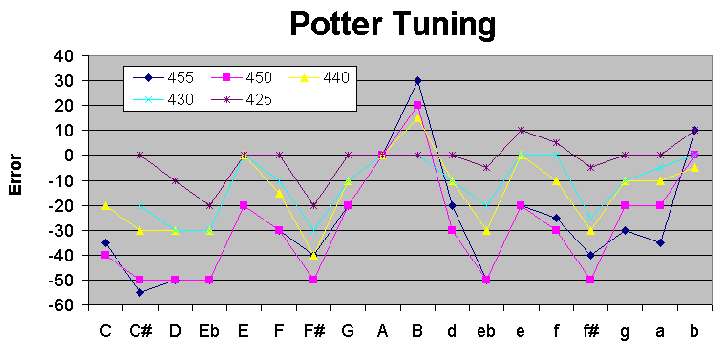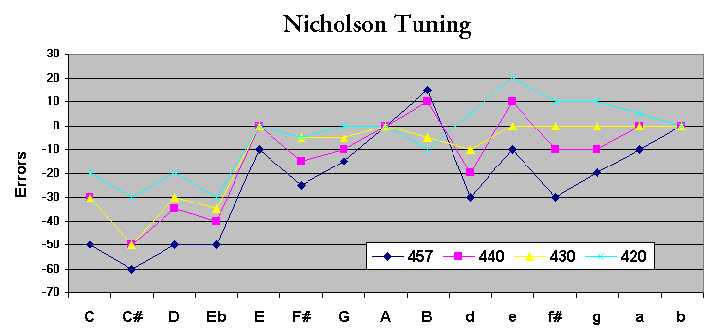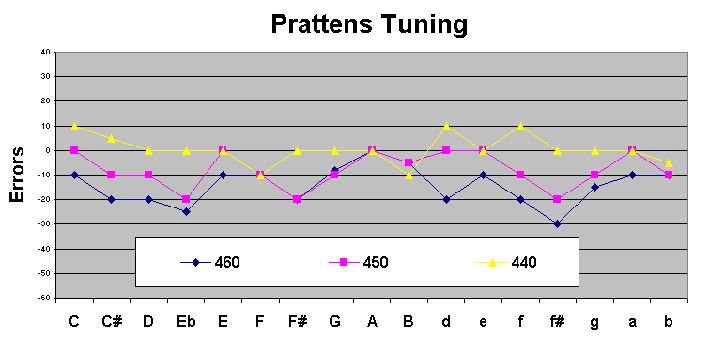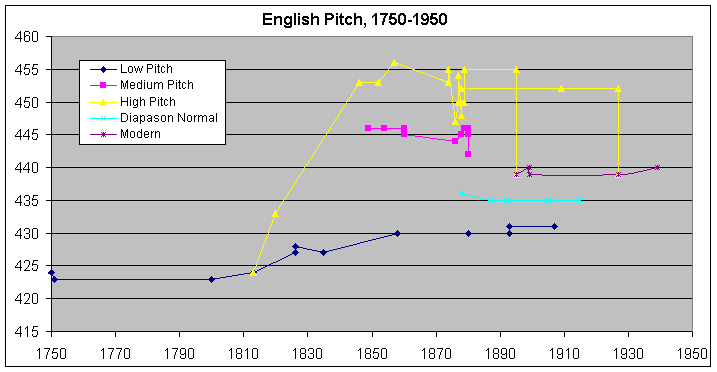IntroductionThis paper presents some information and draws some conclusions about the tuning of English 19th century 8-key flutes. This is a work in progress and would benefit from some refinement, which it will receive as time permits. None-the-less, I believe you will find the material thought-provoking. Out of Tune, or What?A modern flute player confronted with an original 19th century flute will be immediately puzzled by the apparently appalling intonation. Notes near the top of the tube are sharp, while notes near the foot are appallingly flat. A number of theories have been put forward to explain this, including:
I have difficulties with all these theories:
Because there doesn't seem to be much supporting evidence for any of these views, I have looked for an alternative and more likely theory. To develop and support the theory, I have undertaken a number of measurements which are illustrated graphically below. About the MeasurementsI did not measure all the notes. For example, c and c# at the top of the first octave are very negotiable - there are a number of fingerings giving a wide range of pitch. The same could be said for the notes E and e - although they are included, they should not be relied heavily upon. Notes in the third octave are equally negotiable and were not measured. I followed the fingering practice of the time - opening Eb for most notes, and opening the F key as well for F#. The measurements were taken using software designed by Tatsuaki Kuroda for Shakuhachi makers. He very generously modified his program at my request to facilitate measurements at the wide range of pitches needed. You will notice that the resolution of the measurements is fairly coarse. This is not a software issue, but an issue of methodology. It is quite difficult to achieve good repeatability in such measurements and to have claimed a higher resolution would be misleading. A higher resolution could be achieved using a scribe to take the measurements and taking and averaging repeated measurements. The resolution achieved is adequate for our study however. These instruments were made over a period of more than 100
years, and massive developments in flute making and playing took
place in that period. It should not be surprising therefore
to find that what applied to the earlier instruments did not
necessarily apply to the later. It is easy to discern at
least three generations of 8-key flutes spanning the period.
We will look at an example of each of them. First Generation - Potter's Patent FluteThese instruments show the clear influence of their 6 key, 4 key and 1 key predecessors (indeed the earlier forms of the instrument continued to be made long after the introduction of the 8-key). Often in boxwood or ebony, often with ivory bands, with simply formed keys perhaps of the old square flap type, and with the small holes reminiscent of the classical 1-key instrument. Names like Astor, Bilton, Clementi, D'Almaine, Goulding, Milhouse, Monzani, Potter crop up here. Our example is by William Henry Potter, a leading maker of the time. In ebony, with ivory bands, sterling silver keys with his father's patented pewter plugs sealing into fine silver tubes set into the toneholes. Finger holes are fairly uniform - the ratio of hole area between largest and smallest is about 2.
The instrument is fitted with a tuning slide, the outer section of which has three inscribed rings to mark the degree of extension. There are 5 convenient points overall - the fully closed position (marked "6"), the three rings (the first two marked "5" and "4" and the third one unmarked), and the end of the slide. I measured the deviations in pitch at each of these. The slide markings "4", "5" and "6"
hark back to the earlier days when different upper bodies (corps
de rechange) were supplied to handle the different pitches in use.
Second Generation - the Improved eraCharles Nicholson is accredited with initiating the move to large hole flutes, so it seems appropriate to use one of his as our second generation model. Second generation flutes are more commonly made of cocus, have silver rings and silver "saltspoon" keys, have larger holes than the first generation and are a little shorter. The other big name from the period was Rudall & Rose.
Our C. Nicholson's Improved, made by Thomas Prowse, has all
these features, plus the characteristic flattening around the
right hand finger holes advocated by Nicholson. The ratio in
fingerhole area between largest and smallest is now 3. The tuning
slide bears no calibrations, so fully in and three convenient
pitches were selected.
Note in particular the relative flatness of the four foot notes (C, C#, D and Eb). This was a common feature of many first and second generation flutes, but not usually to this extent. It is important to see it as a separate issue that requires separate investigation (see The Great Flat Foot Experiment). Ignoring that for the moment, the benefits of
larger holes in improving intonation is visible in the region
from E upwards. They do this by being able to be more varied in
size. Third Generation - the Perfected AgeAbel Siccama appears to have initiated the third generation with his very successful 10-key Siccama model, in about 1847. It appears that Robert Sydney Pratten revised the design back to an 8-key around 1860. Third generation 8-key flutes have all six finger holes on a long central piece, permitting better placement of the G# key. Cocus is still the favoured wood, keys and rings might be sterling or nickel silver, keycups are now wide and low to accommodate card-backed pads, and keyhole sizes are now in line with finger hole sizes. Some later ones were post mounted. The flutes are again shorter than the previous generations. The big names are Boosey & Co and Hawkes & Son.
Our example is a Boosey & Co Pratten's Perfected. Ratio of hole areas is 2.7. Fully in (460Hz) and two other convenient pitches were used.
Note the substantially improved tuning overall, with no sign
of the "flat foot" problems from the earlier
generations. Comparing the Three GenerationsTo compare all three, we graph the sums of the absolute errors
over the full range of pitches. Because the "flat foot"
effect on the earlier generations would obscure and skew the
results, only notes from E to b are considered for this purpose.
Note how, when the slides are pressed all the way in, all three flutes play at approximately the same pitch, between 455 and 460Hz. The intonation on the Potter is extraordinarily bad at this tuning with accumulated errors about 7.5 times greater than when played at 425. The Prattens and Nicholson and are also quite unacceptable at this pitch, and are about 6 and 4 times more accurate at 440 and 430 respectively. It's quite clear from the above, that, while all these instruments were designed to be capable of playing at around 455 Hz, they were not designed to be played here. So what pitch were they intended to be played at? Trying to determine intent is never easy based on artefacts alone. Artefacts tell you what happened, not why. We need musicological and historical evidence to assist our interpretation. Contemporary EvidenceWe know that there were two pitches called low and high, in the regions of 425-435 and 450-455 respectively. There also seems to have been a compromise pitch at some times, referred to variously as medium, No 2 (out of 3 tuning forks), intermediate, etc. The graph below illustrates what I've been able to find out so far about how various pitches impacted in England in the period of question. To see how this picture was put together, see the accompanying article: The Rise and Fall of English Pitch
To summarise, we start the 19th century at around 425 Hz, move up to 430, head for 445 around the middle of the century, have a brief flirtation with higher pitches around 1875-85 (or perhaps earlier), then plummet back to pitches around 440. The flutes above could easily accommodate all of these, although the intonation would be far better at the low end of the scale. So were 19th century flutes intended to play at these lower pitches? This seems consistent with their tuning, but would require that they be played with the slide extended around 20mm. Is such an extension likely? Rudall's Patent HeadThe Patent head made by Rudall & Rose gives us permission to believe that it was more than likely, it was intended. Rudall & Rose designed this head in an attempt to cover the range of pitches in use, automatically correcting the stopper position at the same time. It was a complex, heavy and expensive option and would hardly have been invented or found favour if this was not deemed important. The operating range of the mechanism is over 30mm, an extension greater than was needed to find the best tuning point on any of the flutes above. If such an extension wasn't necessary, why would Rudall & Rose provide it? The design of their head is such that it required a conscious decision on the degree of extension. The Rudall, Rose or Carte Models StudyInformation gathered in my Rudall, Rose or Carte Models Study is relevant here too. Using the information gathered above, and applying it to instruments in the study, we can estimate the design pitch of these instruments. Appropriately, they would appear to fall into the second generation range (about 430 Hz) up until very late in the century, where our last two examples slip into a length more appropriate to 440 Hz. Potters, Father and Son.A fascinating bit of evidence comes from comparing one of Richard Potter's flutes, made in the days before he introduced the tuning slide, with one of his son William Henry Potter's, made with a tuning slide. The Richard Potter flute (in the Bate collection) has three corps de rechange, marked No 4, 5 and 6 to indicate their pitch. The William Henry Potter flute (in the McGee-Flutes Research Collection) has one body, but a tuning slide in the head, also marked with the numbers 4, 5 and 6. We compare the overall speaking lengths (middle of embouchure to end) and the body scaling of the two flutes (measured between the c# hole and the D# key).
Now, if you were going to take a flute with a fixed length head and three left-hand sections of different length, and replace it with a variable length head (via a tuning slide) and a single left-hand piece, which of the three left-hand pieces would you choose? The shortest, as by pulling out the head you can always go flatter? Or maybe shorten the head and use the middle one so that the intonation would not be too far out either way? Or maybe pick the one you thought was of most general use. And which one did Potter choose? The longest, ie the lowest pitch body, #4 in the table above. Indeed, note that not only is the scale length the same for both #4 bodies, but the overall speaking length is also the same. No surprise then when we find the flute works best with the head well extended. Modern Experience - New FlutesHaving come some time ago to the conclusions reached above, I have used this approach in rescaling my two Rudall & Rose models (one large hole, one medium hole) to give optimum intonation at modern pitch (A440) instead of their original pitches. The results are stunning. Errors throughout the range are insignificant and, because of the optimised inter-octave spacing, the notes speak with substantially greater vibrancy and focus. Modern Experience - Old FlutesRetuning of early 19th century originals for modern pitch provides a test-bed for our theory. Our example is a Clementi flute. Although marked C.Nicholsons Improved and bearing the classic Nicholson combing on head and barrel, it is unmistakably a first generation design. Our graph illustrates this by comparing it with the Potter we saw above. All the measurements are taken at with the tuning slides set for A 440.
Note how similar the Potter and the unmodified Clementi are from the note E up. Note also that the Clementi suffered a bad case of the "flat foot" syndrome we saw in the Nicholson. Note how well in tune the instrument ended up - errors at 440 Hz reduced by up to six times! The modifications needed to produce this were:
a total reduction in length of 16.5mm (>5/8"). If the flute had been intended to be ideal at higher than modern pitch, it would have needed to be lengthened to work properly at modern pitch. If, as I suggest, they were intended to play best in tune at lower pitches, they would need to be shortened to work satisfactorily at 440. On the old 1mm/Hz rule of thumb, we might expect a shift of 425 Hz to 440 Hz to require about 15mm shortening. 16.5 mm shortening is not far out! ConclusionI believe the evidence above is irrefutable. 19th century conical flute makers were not incompetent, we have simply misinterpreted them and their times. Their flutes were made to play best at the low end of their range, presumably because this was the more common requirement. If we are not prepared to accept this, we have to deal with the anomaly that the best tuning does not coincide with where they were to be played, that this improbability afflicted the work of over a hundred flute makers and that this unlikely condition continued for well over 100 years. Or we have to determine what might have changed to give the results above. Bore shrinkage is perhaps the most promising avenue so far and remains to be explored. (Initial results from a study involving re-hydrating the W.H. Potter flute shown above do not look promising. Although weight gain and bore measurements indicate that the flute had been returned to its initial size, no significant changes to intonation were noted. The experiment will be repeated more carefully before a final result is announced.) Whatever the reason for these errors, one thing is clear. When we make precise copies of these instruments for modern use, we are copying the errors seen in the graphs above. If we fiddle the notes without understanding how and why they are wrong, we are unlikely to achieve the best outcomes. If however, we carefully analyse the instrument to determine what was really intended, and then rescale it to modern pitch, we can enjoy all of the skill that went into the original design. Last Updated on
11/10/05 Back to McGee Flutes home page...
|





